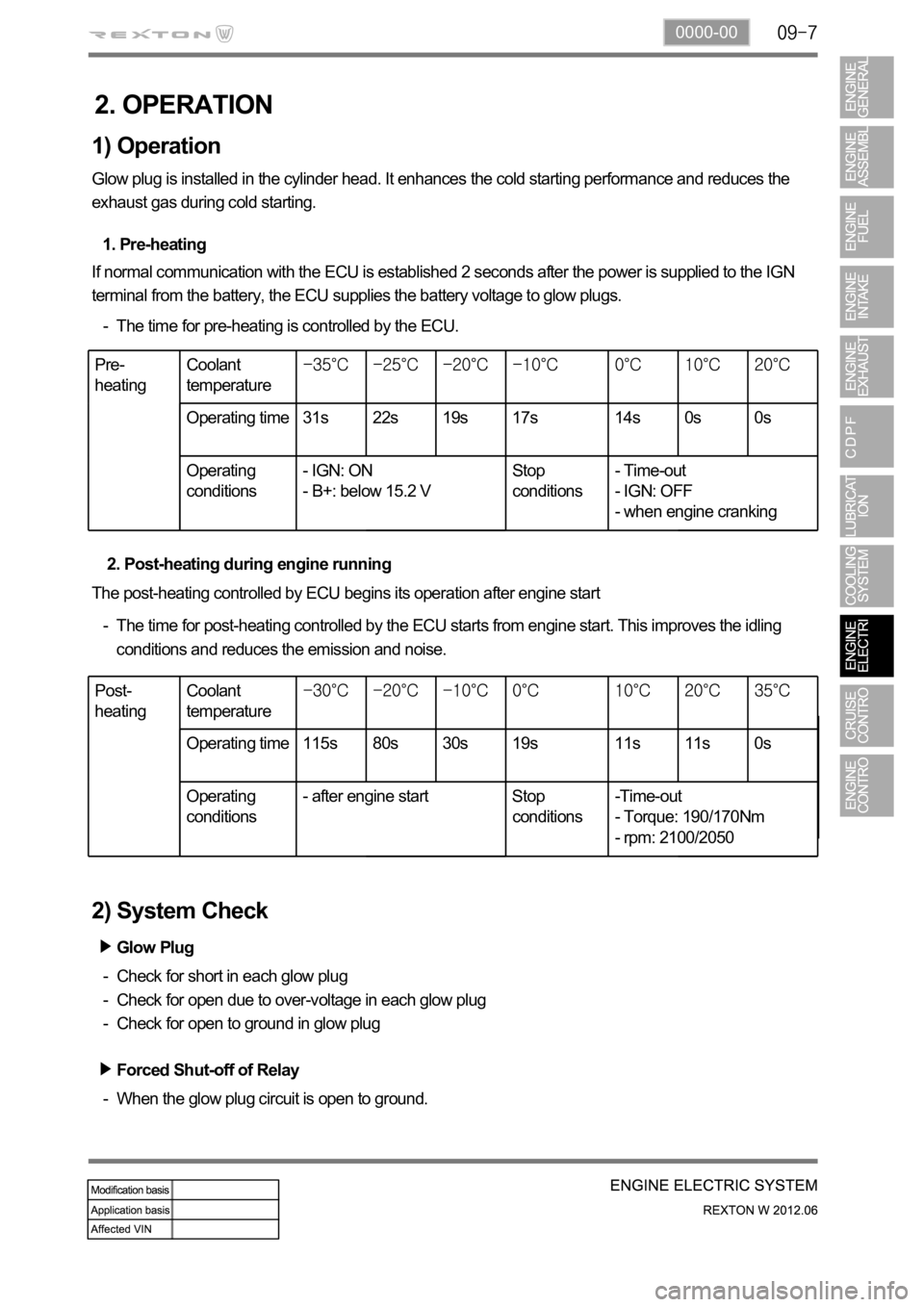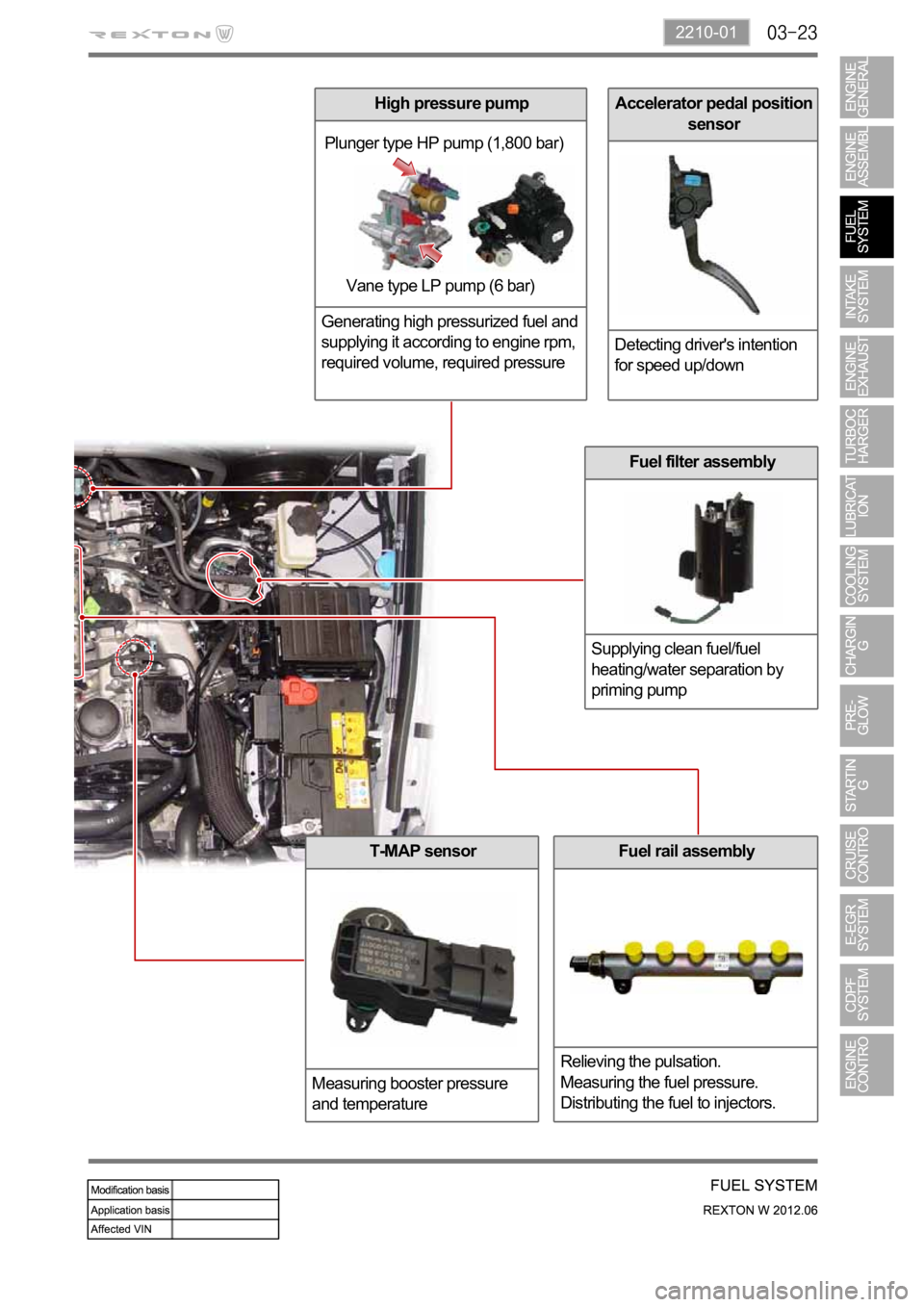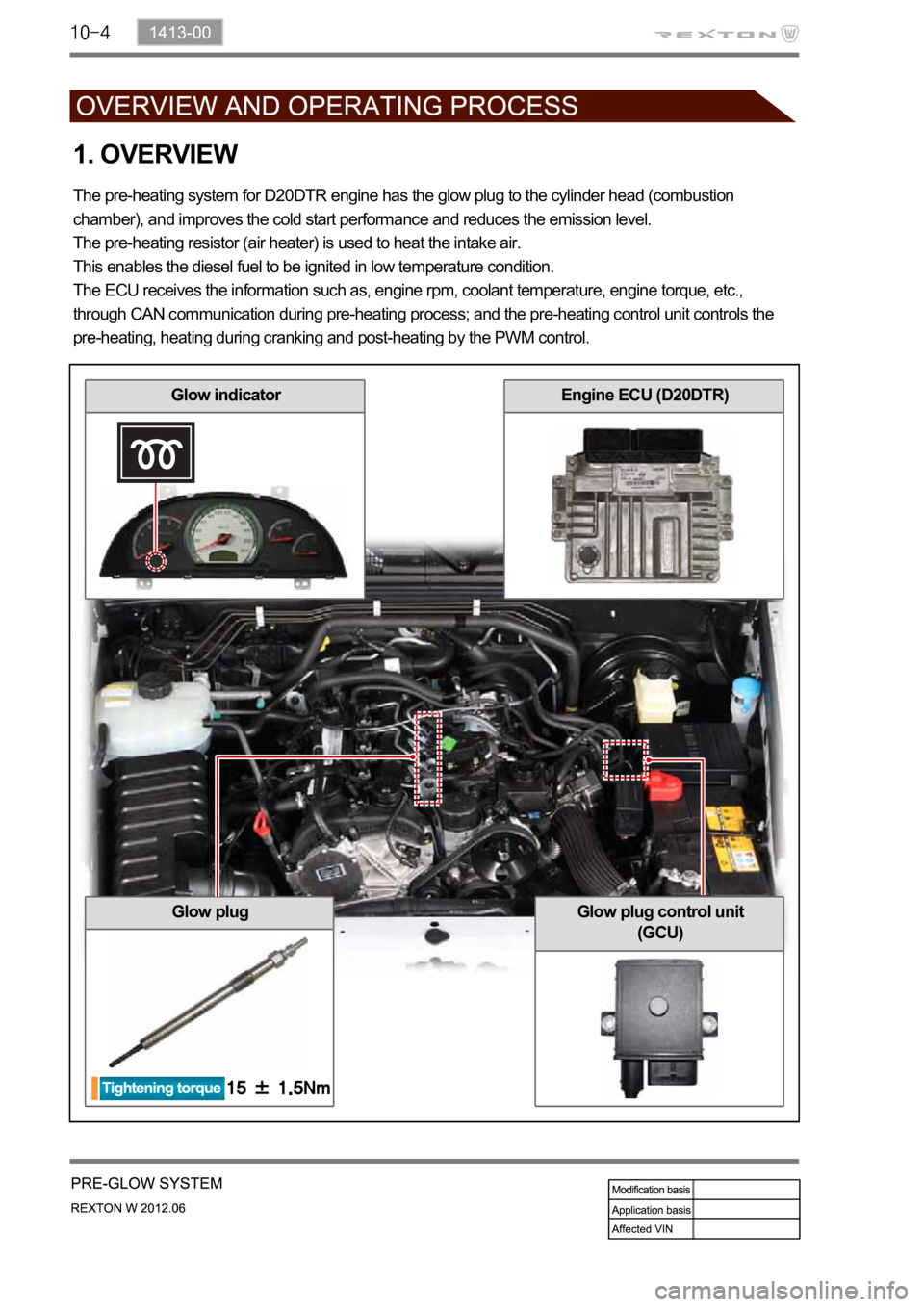heating SSANGYONG NEW REXTON 2012 Service Manual
[x] Cancel search | Manufacturer: SSANGYONG, Model Year: 2012, Model line: NEW REXTON, Model: SSANGYONG NEW REXTON 2012Pages: 600, PDF Size: 73.29 MB
Page 240 of 600

0000-00
1. SPECIFICATIONS
Description Unit Specification
Starter Type - WP220
Output power KW 2.2
No load test (12 volts) A 160
Drive pinion speed at no load rpm 4500
Drive pinion speed at load rpm/A 1700/430
Brush length mm 18
Armature diameter mm 55
Armature run-out mm 0.1
Segment groove depth mm 21.7
Alternator Type - CSI128D
Output voltage/current V/A PTC equipped vehicle: 12V-140A
FFH equipped vehicle: 12V-115A
Regulator type -
Regulating voltage V 14.6
Brush Length mm 12.5
Quantity - 2
Wear limit mm 7
Battery Type - M F
Capacity AH 12V - 90AH
Glow plug Reserved capacity RC 160
Type - Seized type
Rated voltage - 11.5
Circuit connection - Parallel
Preheating time sec
Page 244 of 600

0000-00
2. OPERATION
Glow plug is installed in the cylinder head. It enhances the cold starting performance and reduces the
exhaust gas during cold starting.
1. Pre-heating
2. Post-heating during engine running If normal communication with the ECU is established 2 seconds after the power is supplied to the IGN
terminal from the battery, the ECU supplies the battery voltage to glow plugs.
The post-heating controlled by ECU begins its operation after engine start The time for pre-heating is controlled by the ECU. -
The time for post-heating controlled by the ECU starts from engine start. This improves the idling
conditions and reduces the emission and noise. -
2) System Check
Glow Plug
Forced Shut-off of Relay
Check for short in each glow plug
Check for open due to over-voltage in each glow plug
Check for open to ground in glow plug -
-
-
When the glow plug circuit is open to ground. -
1) Operation
Pre-
heatingCoolant
temperature
Operating time 31s 22s 19s 17s 14s 0s 0s
Operating
conditions- IGN: ON
- B+: below 15.2 VStop
conditions- Time-out
- IGN: OFF
- when engine cranking
Post-
heatingCoolant
temperature
Operating time 115s 80s 30s 19s 11s 11s 0s
Operating
conditions- after engine start Stop
conditions-Time-out
- Torque: 190/170Nm
- rpm: 2100/2050
Page 337 of 600

2210-01
Accelerator pedal position
sensor
Detecting driver's intention
for speed up/down
Fuel rail assembly
Relieving the pulsation.
Measuring the fuel pressure.
Distributing the fuel to injectors.
Fuel filter assembly
Supplying clean fuel/fuel
heating/water separation by
priming pump
Plunger type HP pump (1,800 bar)
Vane type LP pump (6 bar)
T-MAP sensor
Measuring booster pressure
and temperature
High pressure pump
Generating high pressurized fuel and
supplying it according to engine rpm,
required volume, required pressure
Page 377 of 600

2. FUNCTIONS OF LUBRICATION
1) Lubrication
It creates a viscous barrier between moving parts that reduces friction, which means less heat and
longer life for those parts. As a lubricant, oil must maintain a protective film to prevent metal-to-metal
contact. It must be fluid enough to allow easy starting and to circulate quickly through the engine, yet
remain thick enough at higher operating temperatures and speeds to provide adequate lubrication.
2) Cooling
Combustion heat and friction energy must be removed from the engine in order to prevent its
overheating. Most of heat energy is taken by the engine oil.
Clean oil passages, proper viscosity and low contamination provide sufficient flow rate of the engine oil
and effective cooling.
3) Sealing
It helps to seal the space between the pistons and the cylinder walls so that compression is more
effective and power is not lost during combustion.
4) Anti-corrosion
As a corrosion inhibitor, oil coats internal engine parts to prevent surface rust on the inside of the engine
which can be caused by blow-by products and water formed in combustion. It must also be capable of
neutralizing the acids that are formed by combustion blow-by and oil oxidation at high temperatures.
5) Cleaning
The small particles of dirt or other contaminants are suspended in oil and carried away to be filtered out.
As a detergent, engine oil must be able to gather and suspend dirt and other contaminants until the oil
can leave them as it passes through the filter and returns to the internal engine environment.
Page 382 of 600

1520-00
3. CAUTIONS
If 100% of anti-freeze is added, the water pump vane can be damaged and thermal conductivity
can be decreased resulting in poor circulation in the cooling system which leads to overheated
engine.
Use of non-recommended coolant could cause damage to the cooling system and overheating of
the engine.
Opening the coolant reservoir cap while the engine is running or hot can cause burns by hot steam
or water.
To open the coolant reservoir cap, wrap the cap with a wet towel or thick cloth after the engine is
cooled down sufficiently.
If cool water is added to the heated engine, the engine or radiator can be deformed.
The anti-freeze in the coolant can damage the painted surface, so avoid the contact of the coolant
to the painted body.
The anti-freeze and water should be mixed in proper mixture ratio. Never add only water when
adding coolant.
If the anti-freeze content is too low, the coolant can be frozen while the engine can be overheated if
anti-freeze content is too high. -
-
-
-
-
-
-
-
Page 397 of 600

1. OVERVIEW
The pre-heating system for D20DTR engine has the glow plug to the cylinder head (combustion
chamber), and improves the cold start performance and reduces the emission level.
The pre-heating resistor (air heater) is used to heat the intake air.
This enables the diesel fuel to be ignited in low temperature condition.
The ECU receives the information such as, engine rpm, coolant temperature, engine torque, etc.,
through CAN communication during pre-heating process; and the pre-heating control unit controls the
pre-heating, heating during cranking and post-heating by the PWM control.
Glow plug
Glow indicatorEngine ECU (D20DTR)
Glow plug control unit
(GCU)
Page 401 of 600

(3) Operation
Pre-Glow: Step 1
If normal communication with the ECU is established 2 seconds after the power is supplied to the IGN
terminal from the battery, the GCU supplies the battery power to raise the temperature of the glow plug
- The time for pre-heating is controlled by the ECU.
Input power VB(V) Arrival time T1(s)
68.27
75.8
84.1
93.15
10 2.4
11 1.95
1.9
If the input power (VB) is 11.5 V or less, the GCU supplies the battery power for arrival time (T1).
If the input power (VB) is greater than 11.5 V, the GCU supplies the voltage of 11.5 V for arrival time
(T1). -
-
The time for pre-heating by coolant temperature can vary slightly depending on e.g. other vehicle
operation elements.
Page 402 of 600

1413-00
During cranking: Step 2 and step 3
Step 2: If the ECU receives the cranking signal after pre-heating (step 1), the GCU supplies the 1.
2.
Under fixed temperature: The AQGS unit supplies power for 30 seconds (Step 1 + Step 3)
if no cranking signal is received after the step 1.
At cranking: The step 3 is started after the step 2. *
*
Post-glow: Step 4:
The post-heating is for reducing HC/CO after the engine is started. If the time for post-heating exceeds
180 sec., the GCU unit cuts off the power to each glow plug even if there is pre-heating request from the
engine ECU.
Emergency glow
If no CAN signal is received for 4 seconds from the engine ECU after the IGN ON signal is input, the
GCU performs emergency preheat (Step 3) for 30 seconds.
Post-heatingOperating time
(approx.)
Operating time
(approx.)100 s 50 s 25 s 10 s 10 s
Page 433 of 600

2412-02
Front temperature sensor
Measures the temperature of
exhaust gas.
This sensor is located at the rear
side of exhaust manifold and
monitors the temperature of
combusted gas to prevent the
exhaust system from overheating.
When the temperature gets higher,
this sensor cuts off the fuel delivery
and controls the EGR to lower the
temperature.Rear temperature sensor
Measure the outlet
temperature of DOC.
This sensor is located at the
rear side of DOC and
monitors the overheating of
CDPF and post injection
volume.
Engine ECU (D20DTR)
Differential pressure sensor
Measures the difference between
inlet and outlet pressures of CDPF.
If the difference is higher than the
specified value when collecting the
PM, this makes the post injection for
forced recycling of PM.
T-MAP sensorIntake air
mass
Measures
the
excessive
amount of
PM.
Boos
t
pressure
/
temperature
Injector (C31)
Controls the post injection.
Electric throttle body
Controls the intake air mass.
HFM sensor
Wide band
oxygen senso
r
Page 479 of 600

0000-00
(13) PTC heater control
A. Overview
The supplementary electrical heater is installed in DI engine equipped vehicle as a basic equipment. The
PTC system is operated according to two temperature values measured at the coolant temperature
sensor and HFM sensor. This device is mounted in the heater air outlet and increase the temperature of
air to the passenger compartment. Because PTC system is heated by electrical power, high capacity
alternator is required. PTC does not operate during engine cranking, while the battery voltage is lower
than 11 V or during preheating process of glow plugs.
B. Components
HFM (intake air
temperature)
Coolant temperature
sensorPTC heaterD20DTR ECU
PTC 1 relay
PTC 2 relay
PTC 3 relay
PTC Fuse 3 (40A)PTC Fuse 2 (40A)PTC Fuse 1(40A)
Relay box in engine compartment